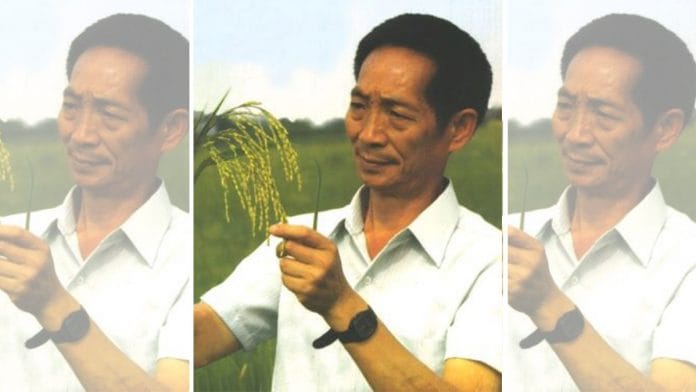New Delhi: Chinese agricultural scientist Yuan Longping, widely credited for developing the first hybrid rice strain, died of organ failure in a hospital in Changsha Saturday, according to the state-run Xinhua news agency. He was 90.
Considered a “miracle worker”, Yuan’s scientific breakthroughs helped China and parts of Asia and Africa alleviate famine and poverty. Huge crowds, reportedly, showed up in Changsha to bid a final farewell as the vehicle carrying Yuan’s body passed by.
Qu Dongyu, Director-General of the UN Food and Agriculture Organization (FAO), also mourned the man who helped “billions achieve food security”. Yuan had served as an International Chief Consultant to FAO during his career.
Known as the ‘Father of Hybrid Rice’, Yuan spent nine years of research trying to create a hybrid rice combination.
It was a feat that seemed impossible given that at the time, heterosis was not believed to be applicable to self-pollinated crops such as rice. According to classical genetics, heterosis is the improved or increased function of any biological quality in a hybrid offspring.
In 1973, Yuan successfully developed the first hybrid rice combination named ‘Nan-you No. 2’ with yields 20 per cent higher than previous varieties. This means that it could feed an extra 70 million people a year. Three years later, Nan-you No. 2 was put into commercial production, transforming China into a surplus grain economy.
In 2004, Yuan won the World Food Prize — considered equivalent to the Nobel Prize in the field of agriculture — for his contribution to food security. In 2019, he was given the Medal of the Republic, China’s highest honour.
ThePrint explains the life of the top agricultural scientist and what inspired his scientific breakthroughs.
Also read: Indian-American soil scientist Dr Rattan Lal wins World Food Prize — ‘Nobel’ of agriculture
Inspiration behind Yuan Longping’s research
“I saw rice plants as tall as Chinese sorghum,” Yuan was quoted as saying while recalling a dream he once had. “Each ear of rice as big as a broom and each grain of rice as huge as a peanut. I could hide in the shadow of the rice crops with a friend.”
Yuan was born in Beijing in 1931 into a poor farmer’s family, according to a report by China state-affiliated media. He later graduated from Southwest Agricultural College in Chongqing in 1953 with a major in agronomy.
What encouraged Yuan’s research into wild rice was the Great Chinese Famine from 1959-1961, which killed up to 45 million people. It occurred a decade after the Communist party took power. He would often say in interviews that his work was driven by the hunger he had witnessed. “My lifetime pursuit is to ensure all people stay away from hunger,” he was quoted by mainland media as saying.
His research began in 1964 when he theorised that a male-sterile grain could be crossed with other plants to boost yields. That year, he published his findings that outlined unique genetic tools required for developing the first-ever hybrid rice. He continued his research after moving in 1971 to Hunan Academy of Agricultural Sciences, where he served as a research professor.
In 1973, he successfully created the hybrid rice after which mass cultivation of it helped increase rice yields in China from 300 kg per mu (4,500kg per hectare) in the 1970s to more than 900 kg per mu (13,500kg per hectare) in 2011.
Also read: What happened when AI and traditional farmers competed in a strawberry-growing contest
Impact of Yuan’s research
The impact of Yuan’s breakthrough was felt across the world. According to the China National Hybrid Rice Research and Development Centre, where the scientist worked, an estimated 8 million hectares overseas have been planted with hybrid rice.
China has also inked agreements on the technology — often termed “rice diplomacy” — with developing countries like Pakistan and the Philippines.
In 1979, shortly after Nan-you No. 2 was mass produced, the Philippines-based International Rice Research Institute also established its hybrid rice programme. That year, China exported hybrid rice for the first time to the US.
In 1992, the first large-scale commercial production of hybrid rice outside China took place in Vietnam, where over 10,000 hectares of hybrid rice were planted. The commercial production of hybrid rice then gradually expanded in Vietnam and other Asian countries outside of China.
A report by International Hybrid Rice Symposium explains that in addition to the projects, FAO teamed up with International Rice Research Institute, the Chinese Hybrid Rice Research and Development Centers and others to establish the International Task Force on Hybrid Rice in 1996.
The Asian Development Bank funded this task force to implement activities of the project from 1998 to 2006.
Towards the end of his life, Yuan was still actively involved in agricultural research. He helped create a strain of rice for areas suffering from heavy metal pollution in 2017 and his team had also been working on developing saline-alkaline tolerant rice.
(Edited by Rachel John)
This report has been updated to accurately reflect that Yuan Longping was 90-years-old at the time of his death and not 91. The error is regretted.
Also read: How WhatsApp & Baba Ramdev are making mustard oil and lemon prices soar






